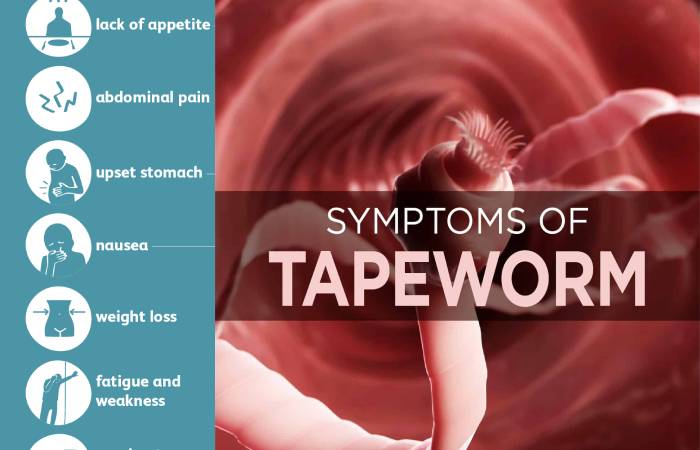Table of Contents
Tapeworm Infection Definition
Tapeworm infection is caused by eating food or water contaminated with tapeworm eggs or larvae.
If you ingest individual tapeworm eggs, they can travel outside the intestines and form larval cysts in the body’s tissues and organs (invasive infection).
Instead, if you eat tapeworm larvae, they turn into adult tapeworms in the intestines (intestinal infection). An adult tapeworm has a head, neck, and a chain of segments called the proglottids.
Intestinal tapeworm infections are generally mild, with only one or two adult tapeworms. However, invasive larval infections can cause serious complications.
What are the Symptoms of Tapeworm Infection?

Many people with an intestinal tapeworm infection have no symptoms. If the condition is causing problems, your symptoms will depend on the type of tapeworm you have and its location. Signs of invasive tapeworm infection vary depending on where the larvae migrated.
Signs and symptoms of intestinal infection include the following:
- Sickness
- Weakness
- Loss of appetite
- Abdominal pain
- Diarrhoea
- Dizziness
- Upset stomach
- An intense desire for salt
Wheather tapeworm larvae travel out of the intestines and form cysts in other tissues, over time, these can cause organ and tissue damage, causing the following:
- Headaches
- Cystic lumps or masses
- Allergic reactions to the larva
- Neurological signs and symptoms, including seizures
What are the Causes of Tapeworm Infection?
A tapeworm infection begins after the ingestion of tapeworm eggs or larvae.
1. Ingestion of Eggs
- If you eat contaminated food or drink water contaminated with faeces from a person or animal with tapeworms, you ingest the microscopic eggs.
- For example, a pig infected with it will pass tapeworm eggs into faeces that enter the soil.
- If that same soil comes into contact with food or a water source, it becomes contaminated.
- Therefore, you can become infected when you eat or drink something from the contaminated source.
- Once inside the intestines, the eggs hatch into larvae. At this stage, the larvae become mobile.
- If they migrate from the intestines, they form cysts in other tissues, such as the lungs, central nervous system, or liver.
2. Ingestion of Larval Cysts
- When an animal has it, it contains its larvae in muscle tissue.
- If you eat raw or undercooked meat shape an infect animal, you consume the larvae that later develop into adult tapeworms in the intestines.
- Adult tapeworms can be over 80 feet (25 m) long and survive up to 30 years in a host.
- Some tapeworms attach to the intestine’s walls, causing mild irritation or inflammation, while others can pass into the stool and leave the body.
Risk Factors of Tapeworm Infection

Factors that can set you at greater risk for a tapeworm infection include:
Poor hygiene Infrequent washing and bathing grows the risk of accidentally passing contaminated matter into the mouth.
1. Exposure to Livestock
It is especially problematic in regions where human and animal faeces are not disposed of properly.
2. Travel to Developing Countries
The infection occurs most frequently in areas where poor hygiene practices implement.
3. Eat Raw or Undercooked Meat
Improper cooking may not kill tapeworm eggs and larvae in contaminated pork or beef.
4. Live in Endemic Areas
In certain parts of the world, exposure to tapeworm eggs is more likely. For example, the risk of coming into contact with pig tapeworm eggs (Taenia Solium) is higher in Latin America, China, sub-Saharan Africa, or Southeast Asia, where the presence of farmed pigs may be more frequent.
Complications of Tapeworm Infection
In general, intestinal tapeworm infections do not cause complications. If you do, some of the difficulties may be the following:
1. Digestive Blockage
- If tapeworms grow big enough, they can block the appendix, leading to infection (appendicitis); the bile ducts, which carry bile from the liver and from the gallbladder to the intestine; or the pancreatic duct, which carries digestive fluids from the pancreas to the intestine.
2. Impairment of the Brain and Central Nervous System
- It significantly risks complications of invasive pig tapeworm infection.
- It can cause headaches and visual impairment and seizures, meningitis, hydrocephalus, or dementia. In severe cases of infection, death can occur.
3. Alteration of the Function of the Organs
- When the larvae move to the liver, lungs, or other organs, they transform into cysts.
- These grow over time and are sometimes large enough to push the organs’ functional parts or reduce their blood supply.
- Tapeworm cysts sometimes rupture, releasing more larvae, moving to other organs, and forming additional cysts.
- A leaking or ruptured cyst can cause an allergic-type reaction, with itching, hives, swelling, and trouble breathing. In many cases, surgery or an organ transplant may be necessary.
Diagnosis of Tapeworm Infection

To diagnose a tapeworm infection, your doctor considers any of the following options:
1. Analysis of Stool Samples
- If you have an intestinal tapeworm infection, your doctor may test the stool or send the samples to a lab for testing.
- The laboratory uses microscopic identification techniques to check for tapeworm eggs or segments in the seat.
- Because the eggs and segments are transmitted unevenly, the laboratory may have to collect two to three samples over some time to detect the parasite.
- Eggs are sometimes present in the anus, so the doctor may use a piece of clear tape pressed to the anus to collect the eggs for microscopic identification.
2. Blood Test
- For invasive tissue infections, the doctor may also test the blood to look at the antibodies that the body may have to fight the tapeworm infection.
- The attendance of these antibodies indicates tapeworm infestation.
3. Imaging Examination
- Certain types of images, such as computed tomography (CT) or magnetic resonance imaging (MRI), x-ray, or ultrasound of cysts, can suggest an invasive tapeworm infection.
Prevention of Tapeworm Infection
To prevent tapeworm infection, do the following:
- Clean your hands with soap and water before eating or handling food and after using the bathroom.
- When travelling to areas where the tapeworm is more frequent, wash, and cook all fruits and vegetables with drinking water before eating.
- If there is a possibility that the water is not safe to drink, be sure to boil it for at least a minute and then allow it to cool before using it.
- Eliminate cattle exposure to tapeworm eggs by properly disposing of animal and human faeces.
- Cook meat thoroughly at least 145 ° F (63 ° C) to kill tapeworm eggs or larvae.
- Freeze meat for 7-10 days and fish for at least 24 hours in a -31 ° F (-35 ° C) freezer to kill tapeworm eggs and larvae.
- Keep away from eating raw or undercooked pork, beef, and fish.
- And also, treat infected tapeworm dogs promptly.
When to See the Doctor
Seek medical attention immediately if you experience any of the signs or symptoms of tapeworm infection.
Conclusion
There is no magic tablet to weight loss, even whether it comes in a tapeworm form. The tapeworm has risk complications, as well as a lack of proof that it can effectively help you lose (and keep off) weight.
However, you can do several healthy strategies to improve your health, which may also help you lose weight.

